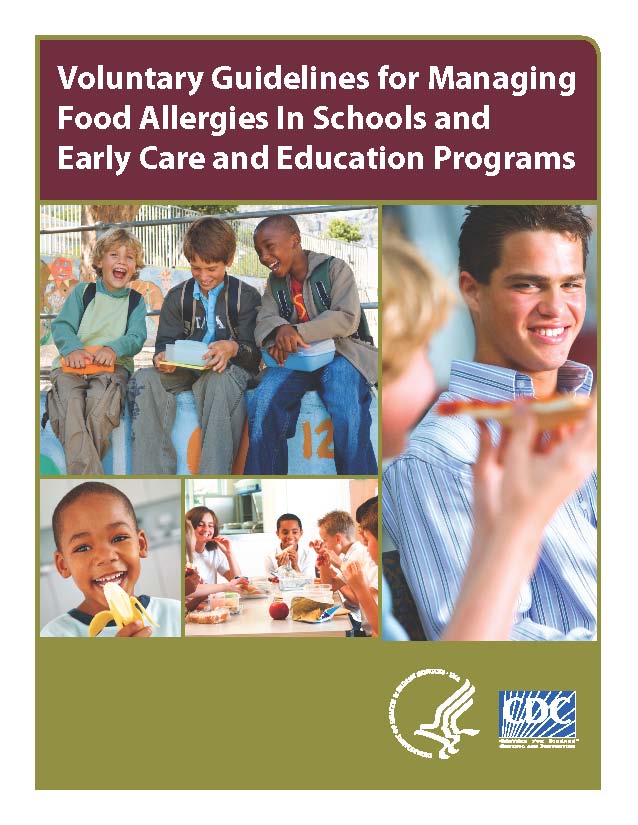Released Today: The CDC Guide to Managing Food Allergies in Schools
 Wednesday, October 30, 2013 at 12:24PM
Wednesday, October 30, 2013 at 12:24PM  Elisabeth Veltman, The Tender Foodie tagged
Elisabeth Veltman, The Tender Foodie tagged  anaphylaxis,
anaphylaxis,  child,
child,  emergencies,
emergencies,  epinephrine,
epinephrine,  food allergy,
food allergy,  food allergy and 14 bullying,
food allergy and 14 bullying,  life-threatening allergy,
life-threatening allergy,  peanut allergy,
peanut allergy,  pediatric,
pediatric,  school
school  Email Article
Email Article  Print Article in
Print Article in  Culinary Institutes,
Culinary Institutes,  Food Allergy Facts,
Food Allergy Facts,  Food Allergy Training,
Food Allergy Training,  Going to School,
Going to School,  Parents/Kids
Parents/Kids Today,October 30, 2013, the Centers for Disease Control & Prevention (CDC) published “Voluntary Guidelines for Managing Food Allergies in Schools and Early Care and Education Programs." It is the first national comprehensive guidelines to help schools manage food allergies in their facilities and with their students.
This guide was created for schools, but I think every parent should download it and read it. It will help parents with food allergic kids understand what you can expect from schools, and also help parents of kids who have no food allergies understand why these regulations are in place. It might even help a parent save a kids life.
A Quick Snapshot of the Guide
The guide was created with the help of a team of experts, including federal agencies with the expertise in food allergies, consumer organizations who give advice on the clinical management of food allergies (like FARE and The American Academy of Pediatrics), organizations who represnt professional groups who work in schools, like school nurses. They also worked with one school district, one state education agency, and two parents of food allergic kids.
The guide also takes into account the emotional needs & symptoms of food allergic kids, as well as guidelines on how to deal with bullying. Emotional needs are important, as well, since "the peanut table" can be a very lonely experience, as can be being forced to eat in the nurse's or principle's office.
The guide describes the symptoms of a classic allergic reaction, and how to recognize it as such from a clinical perspective, including mental and emotional symptoms. A child, for instance might have a sudden mood change or have a "sense of impending doom." I've certainly experienced this as part of a food allergy reaction, and I'm super glad that they included emotional symptoms in the guide.
The guide also gives examples of how a kid might describe a classic allergic reaction (one that might result in anaphylaxis). Here are a few examples:
- It feels like something is poking my tongue.
- There’s a frog in my throat; there’s something
- stuck in my throat.
- My tongue feels full (or heavy).
- My lips feel tight.
- It feels like there are bugs in there
- (to describe itchy ears).
A very important component of the guide is the strategic planning and framework section. It helps the schools set up a system for the school so they can properly and quickly respond to an emergency, and document any emergency, so they can learn from any incident that might occur. This includes guidelines on professional development and training for any staff who has frequent contact with food allergic kids.
It also sets up a system for each child to help prevent and reduce the risk of any emergency, including child/parent education. How many times have we heard that a parent didn't realize that their food allergy posed such a risk for their child? The parent didn't learn from the doctor who diagnosed the child, but learned from an emergency room visit?
There are several sections that describe how to put these guidelines into practice, including checklists and recommended practices from the cafeteria to the bus, to field trips, to outside groups who use the school.
Finally, the guide gives a clear description on the Laws that govern food allergies:
- Section 504 of the Rehabilitation Act of 1973 (Section 504)
- the Americans with Disabilities Act of 1990 (ADA)h
- Governing Statutes and Regulation for U.S. Department of Agriculture’s (USDA) Child Nutrition Programs (CNPs)
- Individuals with Disabilities Education Act (IDEA)
- Family Educational Rights and Privacy Act (FERPA) of 1974
...and a very comprehensive list of federal resourses to help schools and individuals find and understand the laws. These are listed at the end.
This is an incredible resource with a great deal of information, that is very well organized.
Download it here: Voluntary Guidelines for Managing Food Allergies in Schools and Early Care and Education Programs.
You can also read more about this, and find other resources on the FARE website.


